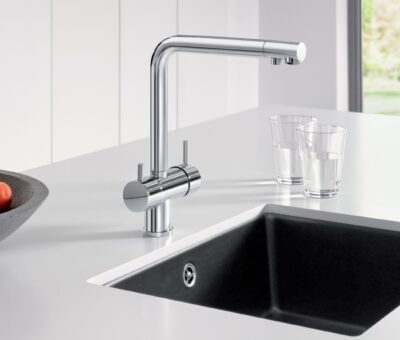The Future of Kitchen Design: Stephanie Forbes Reveals What’s Shaping 2026
Design by Cabinetworks
In this exclusive interview, Stephanie Forbes, National Manager of the Kitchen Specialists Association (KSA), shares her insights on the key design directions, material innovations, and industry shifts shaping South African kitchens heading into 2026.
No matter what the trend is, function should never play second fiddle to form. Good, ergonomic design based on universal design principles will always be the backbone of any good kitchen. That being said, texture is becoming a key component of the new aesthetic, and there is a move towards warmer colours and designs that allow you to express your personality a bit more. Handleless kitchens continue to grow in popularity, and we are seeing a rebirth of the scullery and butler’s pantry. As always in South Africa, entertaining is important, so we are seeing that reflected in design, with more kitchens including bars, coffee stations, and wine displays. Being social is now a huge consideration in kitchen design.
How are global supply chains, material innovations, and sustainability goals influencing product specifications and design choices for 2026?
It is very important to remember that we are not a first-world country, and as such, we don’t have the luxury of prioritising first-world issues. Sustainability should be front of mind for all, but it is a luxury, and sustainable products cost money—pushing the average cost of a kitchen up by over 25%. That is not to say you can’t make sustainably informed choices, such as choosing products from factories with active sustainability programs or opting for finishes with good longevity so that your kitchen lasts as long as possible—reducing wastage.
Material innovation is playing a big role now. We are seeing strides in melamine with stunning textural woodgrains that, to the non-expert eye, could be mistaken for veneer. New colours are emerging in matt and gloss, as well as finishes mimicking materials like linen. There is also local innovation in board products such as black-core MDF. Laminates are being released in amazing crystal finishes and metallics, with some incorporating nanotechnology that allows them to self-heal from minor bumps and scrapes. Fingerprint-resistant technology is also growing in popularity, becoming the cherry on top of the matt trend. Porcelain has become a very fast-growing option for surfacing and cladding, and we are even seeing stone veneers entering the market.
While the world continues to face its fair share of challenges that have affected supply chains, more and more countries are seeking to showcase their products on the global market—creating opportunities for us to discover new products and promote our own innovations.
Which technological advancements — such as smart systems, automation, or AI-driven design tools — are most likely to impact kitchen design and manufacturing over the next year?
Honestly, these are first-world issues. Yes, AI is here and being used, but designing a good kitchen is a very personal process based strongly on understanding individual needs and lifestyles. The big consideration with AI is intellectual property rights—when you upload designs into AI systems, proprietary knowledge becomes part of AI’s learning base, and designers risk losing ownership of their designs. Once uploaded, their work can be used to inspire other designs AI helps to create. As with all things, AI should be used intelligently, with a clear understanding of its benefits and risks.
In Europe, there are only a handful of large kitchen producers who supply retailers, and they invest heavily in production and machine technology. Competition is fierce, so innovations in production are a major asset. In South Africa, however, the market consists mostly of smaller individual manufacturers who don’t have the resources to continually update their production technology. Still, there are a few players with a vision to grow who take a more aggressive stance on production and remain up to date with new technologies to increase efficiency and cost-effectiveness.
Design by Cabinetworks
Are you noticing a move toward more integrated living spaces, and how is that influencing kitchen design thinking among professionals?
As South Africans, we love spaces that morph—indoors becomes outdoors, and kitchen space becomes living space. It suits how we live, play, and entertain. We are most certainly seeing kitchens being designed to appear less functional in aesthetic and more like integrated furniture installations that blend seamlessly with the rest of the home. Pocket door and bi-fold systems allow the kitchen to conceal its practical side, facilitating a “big reveal” when needed. We are also seeing more island designs that include not just casual breakfast areas but also formal dining spaces that can replace traditional dining rooms.
What colour, texture, and surface trends are resonating with specifiers and clients heading into 2026?
While traditional colours will always have a place, there is a move towards warmer tones. Textural finishes that mimic fabrics like linen are a new addition to certain melamine ranges, as are colour finishes with raised grain instead of inset grain. Textured woodgrains with strong grain and knotting are also popular. Finishes that mimic stone for more cost-effective cladding are on the rise as well.
The days of the plain white carcass are gone. The transition of kitchens into more furniture-like spaces has led to an elevation in carcass design, adding sophistication to open units, glass-fronted units, and even standard cabinetry.
The traditional shaker door has also received a revamp into the slim shaker—retaining a hint of the traditional but evolving into a far more contemporary and sophisticated aesthetic.
For surfacing, porcelain is becoming a very popular option, providing that slimline aesthetic. We are also seeing more material combinations and staggered surfacing—incorporating multiple height levels to accommodate different roles and activities in the kitchen.
Overall, the layering of materials will be key—working with multiple finishes to create depth and contrast.
How are fabricators and designers balancing sustainability with durability, cost-efficiency, and client expectations?
They can’t—the average South African can barely afford a kitchen, so to be honest, sustainability plays a very small role. A truly sustainable kitchen would be out of 99.9% of South Africans’ budgets. If you asked the average kitchen manufacturer how often they are asked about material sustainability or required to prioritise it in design, they could count those instances on one hand.
The focus should be on durability and function, followed by aesthetics—but sadly, these are often compromised for cost-effectiveness. Too often, the things that should matter most are sacrificed to achieve the right look at the right price. The South African consumer is always looking for a deal and, unfortunately, is often poorly informed about what goes into a good kitchen and how much that truly costs. Many people believe they’ve spent a fortune on their kitchen, but their budgets often fall within the entry-level range for quality manufacturing.
In terms of layout and functionality, what’s evolving in professional kitchen design for both residential and multi-residential developments?
Sadly, in large developments, little thought is given to practicality and ergonomics—price is the primary factor. However, in private homes, we are seeing greater awareness among designers of universal design principles. Spaces are being designed with greater empathy for users, regardless of who they are. This comes as awareness grows around designing for disabilities (both visible and invisible), for ageing in place, and for neurodivergence. Designers increasingly recognise that the kitchen is more than just a space for food preparation—it must also support physical and psychological well-being.
How is data or market feedback guiding design innovation and consumer product development in the kitchen sector?
Honestly, not much. Most of the innovation we see is imported, and while European consumer feedback may influence those trends, South African consumers play little role in that process. Fortunately, local manufacturers and importers do their best to consider South African tastes and lifestyles when sourcing products, rather than blindly following European trends.
What role do collaborations between manufacturers, designers, and associations like the KSA play in driving forward industry standards and design excellence?
Hopefully, a far greater one than in the past. At the KSA, we’ve started working closely with both the IID and SAFI to create stronger connections and mutual respect between various furniture sectors and built environment professionals. Maria Day of the IID and I have an excellent working relationship and share a vision of fostering better communication and collaboration among industry players. Over the past two years, we’ve encouraged this through joint events and talks aimed at challenging current ways of thinking and working.
Similarly, with SAFI, we are now seeing different furniture sectors uniting to address issues such as cheap imports, lack of export opportunities, and skill and innovation shortages.
Through these efforts, we were able to announce a few weeks ago that the QCTO and our SETA have approved funding for the development of qualifications in kitchen design, kitchen installation, upholstery, and furniture design. Once these are completed—expected by mid-2026—we hope to gain approval for a qualification in kitchen and cabinet making.
Looking ahead, what do you believe will define a future-ready kitchen in 2026 and beyond — in terms of both aesthetics and performance?
The only truly future-ready kitchen is one designed around universal principles, using materials and hardware of quality and durability. This ensures the kitchen remains functional and usable over time, no matter who uses it.
What the future holds is anyone’s guess—technology is moving so quickly. But in South Africa, we move at a more measured pace. Many products introduced here are ones we’re simply not ready for yet. Our lifestyle is robust and very different from that in Europe, and sometimes these new products, appliances, and hardware just don’t suit us. In many ways, I love that.
The future kitchen where everything is done for you seems sterile and removed. Give me a lively South African kitchen, with the braai going outside and everyone mucking in with the cooking, any day—over an app that suggests what I’ll cook and then turns the oven on for me.
Joos Joiners
Contact: KSA
You might also like...
-
Easylife Kitchens: The Ultimate Renovation Checklist for Homeowners

Renovating your home, especially your kitchen, is an exciting journey, but without the right plan in place, it can quickly become overwhelming. Whether you’re updating ...
-
Mambo’s Kitchen Collection: Where Practicality Meets Style

The kitchen is where performance and aesthetics meet. More than just tools, cookware, bakeware, utensils, storage, and serveware set the rhythm of everyday living ...
-
Discover the Timeless Appeal of Blanco Sinks with Classic Luxury

When it comes to enhancing the heart of the home, Classic Luxury proudly presents one of the most trusted names in kitchen innovation — Blanco. ...
-
Sensorline by blu‑line: Elevating Kitchen Architecture

Sensorline fuses cutting-edge technology with minimalist elegance, redefining how we experience built-in stone countertops in kitchens. Be inspired by Blu-line. This innovative system transforms the ...


























